ICSE Biology Previous Year Question Paper 2016 Solved for Class 10
ICSE Paper 2016 BIOLOGY
(Two hours)
Answers to this Paper must be written on the paper provided separately.
You will not be allowed to write during the first 15 minutes.
This time is to be spent in reading the Question Paper.
The time given at the head of this Paper is the time allowed for writing the answers.
Attempt all questions from Section I and any four questions from Section II.
The intended marks for questions or parts of questions are given in brackets [ ].
SECTION-I (40 Marks)
(Attempt all questiohs from this Section.)
Question 1:
(a) Name the following : [5]
(i) The exchange of chromatid parts between the maternal and the paternal chromatids of a pair of homologous chromosomes during meiosis.
(ii) The number of individuals inhabiting per unit area.
(iii) The immunity acquired by providing readymade antibodies from outside for treating certain infectious diseases.
(iv) The pollutants that cannot be broken down to simple and harmless products.
(v) The part of the bra ip that carries impulses from one hemisphere of the cerebellum to the other.
(b) Choose the correct answer from the four options given below : [5]
(i) A plant cell may burst when :
(A) Turgor pressure equalises wall pressure.
(B) Turgor pressure exceeds wall pressure.
(C) Wall pressure exceeds turgor pressure.
(D) None of the above
(ii) The individual flattened stacks of membranous structures inside the chloroplasts are known as :
(A) Grana (B) Stroma (C) Thylakoids (D) Cristae
(iii) The nephrons discharge their urine at the :
(A) Urinary bladder (B) Urethra (C) Renal pelvis (D) Renal pyramid
(iv) Gigantism and Acromegaly are due to :
(A) Hyposecretion of Thyroxine
(B) Hyposecretion of Growth hormone
(C) Hypersecretion of Thyroxine
(D) Hypersecretion of Growth hormone
(v) The mineral ion needed for the formation of blood clot is :
(A) Potassium (B) Sodfrym (C) Calcium (D) Iron
(c) In each set of terms given below, there is an odd one and cannot be grouped in the same category to which the other three belong. Identify the odd term in each set and name the category to which the remaining three belong. [5]
Example: Ovary, Fallopian tube, Ureter, Uterus
Odd term: Ureter
Category: Parts of female reproductive system
(i) Sewage, Newspaper, Styrofoam, Hay.
(ii) Thymine, Cytosine, Adenine, Pepsin.
(iii) Malleus, Iris, Stapes, Incus.
(iv) Cortisone, Somatotropin, Adrenocorticotropic hormone. Vasopressin.
(v) Typhoid, Haemophilia, Albinism, Colour blindness.
(d) Complete the following paragraph by filling in the blanks (i) to (ii) with appropriate words : [5]
The amount of urine output is under the regulation of a hormone called (i) ……… secreted by the (ii) ……… lobe of the pituitary gland. If this hormone secretion is reduced, there is an increased production of urine. This disorder is called (iii) ……… Sometimes excess glucose is passed with urine due to hyposecretion of another hormone called (iv) ……… leading to the cause of a disease called (v) ……… .
(e) State the exact location of the following structures : [5]
(i) Centromere (ii) Chordae tendinae (iii) Thyroid gland (iv) Ciliary body (v) Proximal convoluted tubule.
(f) Given below is a diagram depicting a defect of the human eye, study the same and then answer the questions that follow : [5]
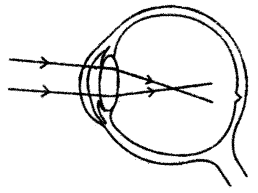 (i) Name the defect shown in the diagram.
(i) Name the defect shown in the diagram.
(ii) What are the two possible reasons that cause this defect ?
(iii) Name the type of lens used to correct this defect.
(iv) With the help of a diagram show how the defect shown above is rectified using a suitable lens.
(g) Given in the box below are a set of 14 biological terms. Of these, 12 can be paired into 6 matching pairs. Out of the six pairs, one has been done for you as an example.
Example: endosmosis – Turgid cell.
Identify the remaining five matching pairs:
Cushing’s syndrome, Turgid cell, Iris, Free of rod and cone cells, Colour of eyes, Hypoglycemia, Active transport, Aerosome, Addison’s disease, Blind spot, Hyperglycemia, Spermatozoa, Endosmosis, Clotting of blood.
(h) State the main function of the following: [5]
(i) Lymphocytes of blood
(ii) Leydig cells
(iii) Guard cells
(iv) Eustachian tube
(v) Corpus luteum
Answers:
(a) (i) Crossing over (ii) Population density (iii) Passive immunity (iv) Non biodegradable (v) Pons varoli
(b) (i) (B) Turgor pressure exceeds wall pressure.
(ii) (C) Thylakoids
(iii) (C) Renal pelvis
(iv) (D) Hypersecretion of Growth hormone
(v) (C) Calcium
(c) (i) Odd term: Styrofoam
Category: Biodegradable wastes.
(ii) Odd term: Pepsin
Category: Nitrogen bases of DNA molecule.
(iii) Odd term: Iris
Category: Ear ossicles/Tiny bones present in the middle ear.
(iv) Odd term: Cortisone
Category: Hormones secreted by Pituitary gland.
(v) Odd term: Typhoid
Category: Sex linked inheritence.
(d) (i) Antidiuretic hormone
(ii) Posterior
(iii) Diabetes insipidus
(iv) Insulin
(v) Diabetes mellitus
(e) (i) Centromere: Between two chromatids of a chromosome.
(ii) Chordae tendinae: At the flaps of the bicuspid and tricuspid valves.
(iii) Thyroid gland: In front of the neck/lower part of the neck below the larynx.
(iv) Ciliary body: Extension of choroid layer as a muscular ring around the lens.
(v) Proximal Convoluted Tubule: In the cortex of the kidney.
(f) (i) Myopia.
(ii) 1. The eye ball is too long from front to back.
2. The lens is too curved.
(iii) Concave lens
(iv)
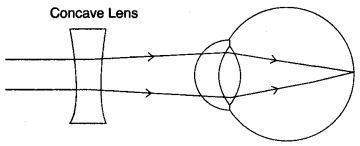
(g) (i) Hyperglycemia: Cushings syndrome
(ii) Hypoglycemia: Addison’s disease.
(iii) Blind Spot: Free of rod cells and cone cells.
(iv) Iris: Colour of eyes.
(v) Acrosome: Spermatozoa.
(h) (i) Lymphocytes of blood: Produce antibodies.
(ii) Leydig cells: Secrete male sex hormone testosterone.
(iii) Guard cells: Regulate the opening and closing of stomata in leaf to facilitate transpiration and exchange of gases.
(iv) Eustachian tube: Balance air pressure on either sides of the ear drum. So that ear drum can vibrate freely.
(v) Corpus luteum: Secretes hormones oesterogen, progesterone and relaxin.
SECTION-II (40 Marks)
(Attempt any Four questions from this Section.)
Question 2:
(a) The figure given below is a diagrammatic representation of a part of the cross section of the root in the root hair zone. Study the same and then answer the questions that follow : [5]
 (i) Name the parts indicated by the guidelines 1 to 4.
(i) Name the parts indicated by the guidelines 1 to 4.
(ii) Which is the process that enables the passageqf water from the soil into the root hair ?
(iii) Name the pressure that is responsible for the movement of water in the direction indicated by the arrows. Define it.
(iv) Due to an excess of this pressure sometimes drops of water are found along the leaf margins of some plants especially in the early mornings. What is the phenomenon called ?
(v) Draw a well labelled diagram of the root hair cell as it would appear if an excess of fertiliser is added to the soil close to it.
(b) Differentiate between the following pairs on the basis of what is mentioned within brackets : [5]
(i) Human skin cell and. Human ovum (number of chromosomes)
(ii) Sperm duct and fallopian tube (function)
(iii) Red Cross and WHO (one activity)
(iv) Rod cells and cone cells (pigment)
(v) LUBB and DUP (names of the valves whose closure produce the sound)
Answer:
(a) (i) 1. Root hair 2. Soil water 3. Xylem Vessels 4. Cortical cells.
(ii) Osmosis Process
(iii) Osmotic pressure: The pressure exerted by a solution to prevent the entry of water molecules, through the semi -permeable membrane is called Osmotic pressure.
(iv) Guttation.
(v)
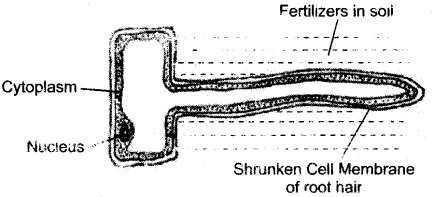
(b) (i) Human skin cell: 46 Chromosomes
Human ovum: 23 Chromosomes
(ii) Sperm Duct: Transfer mature sperm from testis for release. Fallopian Tube : Site of fertilisation in human female.
(iii) Red Cross: Supply blood to victims of war.
WHO: Set, pharmaceutical standards.
(iv) Rod cells: Rhodopsin
Cone cells: Iodopsin
(v) LUBB: Atrioventricular valves
DUP: Semilunar valves.
Question 3:
(a) Given below is the outline of the human body showing the important glands : [5]
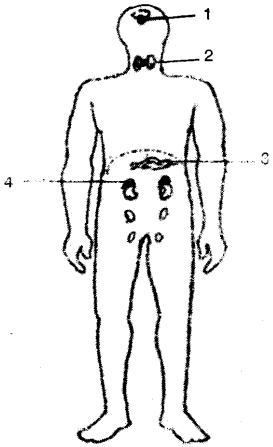 (i) Name the glands marked 1 to 4.
(i) Name the glands marked 1 to 4.
(ii) Name the hormone secreted by part 2. Give one important function of this hormone.
(iii) Name the endocrine part of the part numbered 3.
(iv) Why is the part labelled 1 called, the master gland ? Which part of the forebrain controls the gland labelled 1 ?
(v) Name the gland, that secretes the ’emergency hormone’.
(b) The. diagram of an apparatus given below demonstrates a paniadar process in plants. Study the same and answer the Questions that follow. [5]
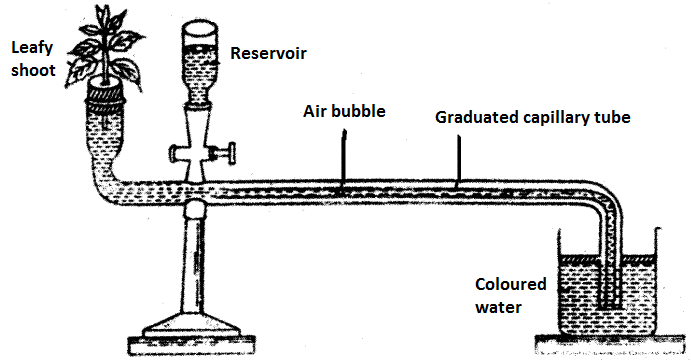 (i) Name the apparatus.
(i) Name the apparatus.
(ii) Which phenomenon is demonstrated, by this apparatus
(iii) Explain the phenomenon mentioned in (ii) above.
(iv) State two limitations of using this apparatus.
(v) What is the importance of the air bubble in, the experiment ?
(vi) Name the structures in a plant through which the above process takes place.
Answer:
(a) (i) 1. Pituitary gland.
2. Thyroid gland
3. Pancreas
4. Adrenal gland
(ii) Thyroxine. It regulates basal metabolism of the body.
(iii) Islets of Langerhans.
(iv) Because it controls the secretions of all the other endocrine gland. Hypothalamus controls it.
(v) Adrenal medulla (part of Adrenal gland.)
(b) (i) Ganong’s potometer
(ii) Transpiration
(iii) The process in which water is given out in the form of vapour through the aerial parts of the plant.
(iv) 1. The small twig can not remain alive for a long time.
2. Introducing a single air bubble is practically very difficult.
(v) The movement of the air bubble shows the amount of water transpired by the twig in a given time.
(vi) 1. Cuticle 2. Stomata 3. Lenticel
Question 4:
(a) (i) Draw a well labelled diagram of the membranous labyrinth found in the inner ear.
(ii) Based on the diagram drawn above in (i) give a suitable term for each of the following descriptions :
1. The sensory cells that helps in hearing.
2. The part that is Responsible for static balance of the body.
3. The membrane covered opening that connects the middle ear to the inner ear.
4. The fluid present in the middle chamber of cochlea.
5. The structure that maintains dynamic equilibrium of the body. [5]
(b) Give the Biological / technical term for the following : [5]
(i) Complete stoppage of menstrual cycle in females.
(ii) Pigment providing colour to urine.
(iii) The vein which drains the blood from the intenstine to the liver.
(iv) The canal through which the testes descend into the scrotum just before the birth of a male baby.
(v) The process causing an undesirable change in the environment.
(vi) The removal of nitrogenous wastes from the body.
(vii) The repeating components of each DNA strand lengthwise.
(viii) An alteration in the genetic material that can be inherited.
(ix) The process of uptake of mineral ions against the concentration gradient using energy from the cell.
(x) Blood vesels carrying blood to the left atrium.
Answer:
(a) (i)

(ii) 1. Organ of corte 2. Utriculus and sacculus 3. Oval window 4. Endolymph 5. Semicircular canals
(b) (i) Menopause
(ii) Urochrome
(iii) Hepatic portal vein
(iv) Inguinal canal
(v) Pollution
(vi) Excretion
(vii) Nucleotide
(viii) Mutation
(ix) Active absorption
(x) Plumonary veins
Question 5:
(a) The given diagram shows a stage during mitotic division in an animal cell: [5]
 (i) Identify the stage. Give a reason to support your answer.
(i) Identify the stage. Give a reason to support your answer.
(ii) Draw a neat labelled diagram of the cell as it would appear in the next stage. Name the stage.
(iii) In what two ways is mitotic division in an animal cell different from the mitotic division in a plant cell ?
(iv) Name the type of cell division that occurs during : A. Growth of a shoot B. Formation of pollen grains
(b) Give scientific reasons for the following statements : [5]
(i) Colour blindness is more common in men than in women.
(ii) Injury to medulla oblongata leads to death.
(iii) When an ovum gets fertilized, menstrual cycle stops temporarily in a woman.
(iv) Mature erythrocytes in humans lack nucleus and mitochondria.
(v) Blood flows in arteries in spurts and is under pressure.
Answer:
(a) (i) Prophase
Reason : Chromosomes clearly visible as paired chromatids connected by centromere. Centrosome split into centrioles and are moving to opposite poles. Nuclear membrane and nucleolus disappearing. Chromosomes not arranged in any pattern.
(ii)
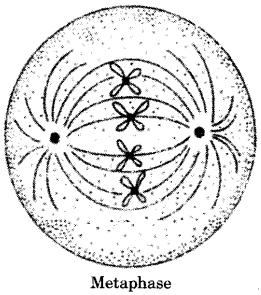
(iii)
| Mitotic in Plant cell | Mitotic in Animal cell |
| 1. Centrosome and centrioles absent. | 1. Centrosome and centriole present |
| 2. Cell plate developing from centre and glowing towards periphery during cytokinesis. | 2. Cell furrow developing from periphery grows towards centre during cytokinesis. |
(iv) A – Mitosis.
B – Meiosis.
(b) (i) Colour blindness is an X-linked inheritence. Women have two X- chromosomes. so even when one X-chromosome carry colour blindness, the other X-chromosome over comes the abnormal trait Whereas men have only one X-chromosome. So when it is affected the man becomes a colour blindness.
(ii) Medulla oblongata controls the involuntary activities like respiration, heart beats etc. So any injury to this part of brain arrests these movements and cause death.
(iii) Menstrual cycle occurs due to rupture and shedding oi the endometrium lining of the uterus. When an ovum gets fertilised the endometrium gets thickned, and vascularized to house the embryo. So during the whole term when the embryo/foetus is in the uterus, menstrual cycle stops temporarily.
(iv) Presence of nucleus would occupy space and reduce the oxygen carrying capacity. Nucleus is also not required as a mature RBC does not divide. Mitochrondria is absent so that oxygen is not consumed by the RBC and all the oxygen is transported to target areas.
(v) Arteries carry blood from heart. With every pump of heart blood flows with a jerk and pressure through it.
Question 6:
(a) The diagram given below is that of a developing human foetus. Study the diagram and then answer the questions that follow : [5]
 (i) Label the parts numbered 1 to 3 in the diagram.
(i) Label the parts numbered 1 to 3 in the diagram.
(ii) Mention any two functions of the part labelled 2 in the diagram.
(iii) Explain the significance of the part numbered 3 in the diagram.
(iv) Define the term ‘GestationWhat is the normal gestational period of the developing human embryo ?
(v) Mention the sex chromosomes in a male and female embryo
(b) The following diagram demonstrates a physiological process taking place in green plants. The whole set up was placed in bright sunlight for several hours. Study the diagram and answer the questions that follow :
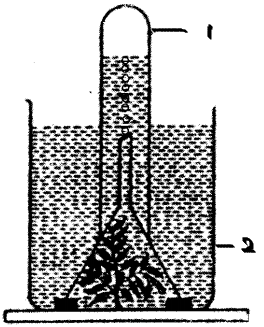 (i) What aspect of the physiological process is being examined ?
(i) What aspect of the physiological process is being examined ?
(ii) Explain the physiological process mentioned in (i) above.
(iii) Label the parts numbered 1 and 2 in the diagram.
(iv) Write a well balanced chemical equation for the physiological process explained in (ii) above.
(v) What would happen to the rate of bubbling of the gas if a pinch of sodium bicarbonate is added to the water in the beaker ? Explain your answer.
Answer:
(a) (i) 1. Umbilical cord 2. Placenta 3. Amniotic cavity/Amniotic fluid
(ii) Functions of Placenta:
1. Transfer nutrients and oxygen from mother’s blood to foetus.
2. Releases hormones called oestrogens, progesterone.
(iii) Significance of Amniotic Fluid:
1. Protects the foetus against jerks, mechanical shocks, and injury.
2. Allows foetus movements.
3. Keeps the pressure even, around the foetus.
4. Prevent sticking of foetus to the amnion.
(iv) Gestation : The full term of development of the embryo in the uterus.
In a developing human embryo gestational period is of 280 days.
(v) Male embryo = XY
Female embryo = XX.
(b) (i) Photosynthesis.
(ii) The process in which plant cells having chlorophyll take raw materials like carbondioxide from air & water from soil and manufacture glucose in presence of light. Oxygen is a waste product during this process.
(iii) Part 1 – Oxygen gas.
Part 2 – Hydrilla plant.
(iv)

(v) Rate of bubbling of gas suddenly increases on adding a pinch of sodium bicarbonate.
Sodium bicarbonate releases carbon dioxide into the water which is made available to the plant. This.increases the rate of photosynthesis. So more oxygen is released thus more bubbles released.
Question 7:
(a) A homozygous tall plant (T) bearing red coloured (R) flowers is crossed with a homozygous dwarf (t) plant bearing white (r) flowers : [5]
(i) Give the genotype and phenotype of the plants of F1 generation.
(ii) Mention the possible combinations of the gametes that can be obtained from the F1 hybrid plant.
(iii) State the Mendel’s law of Independent Assortment.
(iv) Mention the phenotypes of the offsprings obtained in F2 generation.
(v) What is the phenotypic ratio obtained in F2 generation ?
(b) Briefly explain the following terms : [5]
(i) Reflex action
(ii) Power of accommodation
(iii) Photophosphorylation
(iv) Hormone
(v) Synapse
Answer:
(a) (i) Genotype of F1 generation : Tt Rr
Phenotype of F1 generation : All heterozygous tall and red.
(ii) TR: Tall and Red
Tr: Tall and White
tR: Dwarf and Red
tr: Dwarf and White
(iii) Mendel’s law of independent Assortment: “In a dihybrid cross, one pair of character is independent of the other pair during gamete formation.”
(iv) Tall & Red
Tall & White
Dwarf & Red
Dwarf & white
(v) 9 : 3 : 3 : 1
(b) (i) Reflex action: A quick and involuntary action built-in-response to a stimulus.
(ii) Power of accomodation: It is the power and adjustment of our eyes to focus objects at different distances.
(iii) Photophosphorylation: The conversion of Adenosine diphosphate (ADP) to Adenosine triphosphate (ATP) with one inorganic phosphate by light.
(iv) Hormone: A chemical messengers secreted by endocrine glands which reaches its destination by the blood stream and which has the power of influencing the activity of other distant target organs.
(v) Synapse: It is the point of contact between the axon endings of one neuron comes in contact with dendrites of the other neuron through a synaptic cleft.
